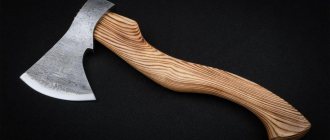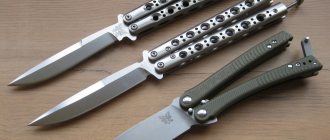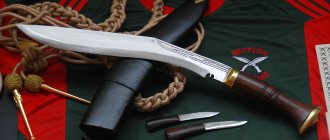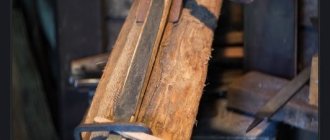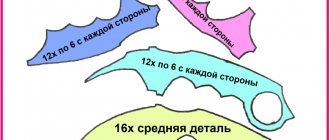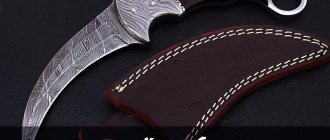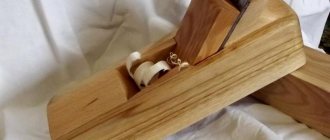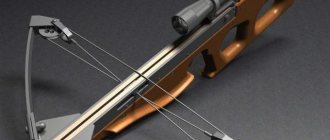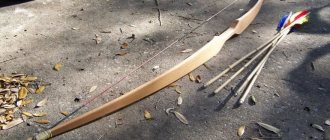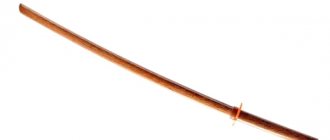Sharpening a knife blade to razor sharpness is a simple matter. Following the sequence of actions, relying on your own acquired experience, ensures a certain pleasure from the result obtained. To do this, it is enough to have a sharpening station or a high-quality sharpener and know the rules for obtaining a high-quality sharpened blade, which are included in the instructions for these devices.
Types of knives and their purpose
Modern classification divides knives into the following categories:
- Combat. They are bladed weapons and are in service with the army as an addition to firearms. They are not intended for free sale and use.
- Tourist. Available for purchase, not prohibited from wearing, the handle and sheath are usually made of synthetic materials.
- Hunting. They have a varied form and purpose of use: work on cutting up hunted game, skinning, arranging a hunting area. Some types require permission to purchase and carry.
- Foldable or collapsible. A very common type, loved by all age categories of people. As the name suggests, the blade folds and the cutting edge fits into the handle. Some types are equipped with clips for attaching to a belt or pocket.
- Multitool A folding multifunctional knife with a set of tools - indispensable for travel and repairs. The standard sample includes: a small and large blade, pliers, screwdrivers, wrenches, a ruler, a hook, and scissors.
- Special purpose. A tool used in certain branches of human activity: medicine (scalpel), diving, Ministry of Emergency Situations, gardening.
- Campers or bivouacs. They are quite large in size and weight. Designed for setting up a tourist camp and clearing the area of the recreation area from bushes and small trees. An example is a machete or kukri. In practice, they easily replace an ax, but at the same time, they remain knives.
- Mark or sports knife for throwing. It is all-metal, without a cutting edge, and is designed to hit a target with a hand throw.
- Kitchen. Used for cooking, they come in a variety of shapes, sizes, thicknesses and blade configurations.
- Dining rooms. They have a certain shape with a rounded tip of the blade, the main purpose is to make eating easier.
- For survival. Positioned as assistants in extreme conditions. They have a number of features: the presence of a compass, a hollow handle that can accommodate a survival kit (a lighter, a fishing line with a sinker and a hook, a thread and a needle, an antiseptic, an antibiotic).
Recommendations
When considering the question of how to sharpen knives on a sharpening machine, do not forget about safety precautions.
A machine, even the smallest one, poses quite a serious danger to humans.
Therefore, it is recommended to check several aspects before starting work.
- Clothes should not hang loose, have laces or other elements not tucked in. This is necessary to ensure that the machine does not accidentally snag a lace or, for example, a sleeve, as this can lead to harm to human health.
- You need to wear protective gloves when working. A standard requirement when working with virtually any tools and machines, gloves protect the skin of your hands from metal dust and shavings.
- It is necessary to wear safety glasses while working. Glasses protect your eyes from metal dust, shavings, and sparks.
A simple set of rules that will reduce the risk when working at the machine to a minimum.
Rules for sharpening knives
The knife is the oldest invention of mankind, a tool that cannot be replaced in everyday life and in human work. Thousands of years of use, modernization of the form and materials used, has led to the emergence of household items with different uses and purposes. When sharpening knives, pay attention to the following:
- You need to work starting with a larger abrasive.
- The last stage of grinding is used on stone with the finest fractions.
- Razor sharpness is provided by genuine leather and ceramics.
- The standard sharpening angle is 20º. The need for others is indicated by the manufacturer in the instructions. Typically, a larger one is required for rough work.
- The larger the angle, the more metal is removed.
- When sharpening the knife, hold the handle and the tip of the blade with both hands.
- To prevent overheating, wetting with water is performed.
Cutting edge and abrasives for sharpening
Despite the apparent simplicity of sharpening the blade, in fact the shape of the cutting edge looks quite complex. The sharpening angle creates only the general edges of the cutting edge; the edge itself is formed by the leads, narrow strips of the blade, which constitute the edge that cuts the material.
In order to remove the cutting edge of the blade, it is necessary to process the slopes with abrasive, creating a wedge.
Selecting an abrasive is not an easy task; in the modern world, various types of synthetic sharpening materials are widely used, such as electrocorundum or diamond bars with a binder.
But, as before, professional sharpeners believe that the best result is achieved only when using abrasive bars of natural origin: novaculite or Arkansas, Japanese water stones.
Sharpening knives requires the mandatory use of oil or water. This allows you to wash away dirt and solid abrasive particles from under the blade, which would otherwise scratch the blade; in addition, the presence of lubricant will protect the surface of the stone from ingrained dirt and metal shavings.
It should be noted that the surface of the sharpening stone must be perfectly flat, otherwise the cutting edge will be wavy, which will have an ambiguous effect on the quality of sharpening.
You need to be especially careful when sharpening a knife one and a half times; in this case, there is a risk of cutting your hand when sharpening on the sharp edges of the blade. For perfect sharpening, it is necessary to alternately change the grain size of the stone, moving from coarse grain, whose task is to roughly create edges and descents, and ending with polishing, which polishes descents and creates leads.
The grain size of the abrasive is determined by the size of its particles; the larger the particle size, the rougher the processing of the blade edges.
It is optimal to have 2-3 whetstones with different values for sharpening a knife. The first one is for rough sharpening, the second one is for edging and the third one is for grinding. Although the final straightening can be done with a polished piece of steel, a leather belt or a ceramic block.
Rules for using a whetstone
To ensure the desired cutting qualities of the knife, the following recommendations should be taken into account:
- Soak the stone in water for 15 - 20 minutes;
- to work you need a table in a well-lit place or with a lamp;
- to prevent the stone from slipping and damaging the table covering, place a cloth or paper on the table;
- to visually determine the sharpening angle of the knife, the blade is applied to the sharpening stone;
- the blade being sharpened is directed away from you at the selected angle;
- with gentle pressure, a reciprocating movement is produced, simulating cutting off a thin film from a grindstone along its entire plane. In this case, the blade moves relative to the block from the handle to the tip and back;
- the selected sharpening angle is maintained during each stroke of the stone;
- the blade and stone are periodically moistened with water and cleaned;
- after 20 - 30 repetitions on both sides of the blade, the cutting edge is inspected. When sharpened with a razor, it is not visible to the naked eye;
- The sharpness of the blade is checked on a sheet of paper by cutting it from top to bottom. A sufficiently sharp blade cuts and does not tear paper.
Folk remedies for washing dishes - benefits, savings or a waste of time
Main questions.
- Does the quality of the metal affect long-term performance?
Yes, it does. The stronger and harder the metal alloy on the tip, the longer the sharpening will last, even with intensive use.
- Which angle is better to choose?
Each such sharp object is unique. Accordingly, each tool will have its own sharpening angle: from 5° to 45°. For greater sharpness, you need to choose a smaller angle. In our workshop, so the work is carried out conscientiously. It is possible to radically change the angle, but it will take more time.
| An incorrectly selected sharpening angle will reduce the quality of the tool. Our specialists guarantee the quality of tool sharpening |
- What are our additional features?
The Studio Sharp workshop in Moscow provides sharpening services for kitchen knives and flat knives at a completely inexpensive price. If the edge becomes dull over time, you can sharpen it yourself. For this purpose, we sell diamond-coated moussates.
| Kitchen scissors are no less important tool than knives and also require timely sharpening. Otherwise, the tool will tear the meat, and you will have to use quite a lot of force to bite through small bones. |
- Is it possible to sharpen an ax?
Yes, we perform similar work using several abrasives. Ideally, you need to make a wide edge, and then process it at an angle of 15° - 20° using a fine abrasive. This ax will last a long time and will not require sharpening.
Our price
To work with us, you don’t need a lot of finance, and we provide a guarantee for all types of work. If, after completing the work, the result does not satisfy your requests, no payment is taken. But this happens extremely rarely.
The price depends on the steel, the length of the tip, the thickness of the metal and ranges from 150 to 350 rubles.
Hunting - 300-350 rubles.
Japanese – 200-250 rub.
It is very difficult, almost impossible, to sharpen your instrument perfectly at home. To do this you will need bulky equipment and simple skills. Therefore, in order to avoid unwanted injuries, we recommend using the services of Sharp Studio, which is located near the Ploshchad Ilyich metro station.
Basics of our work:
- Professional service.
- Work guarantee.
- Perfect result.
- Sharpening accuracy.
At what angle should knives be sharpened, and how to fix the knife when sharpening
The main conditions that determine the sharpening angles of the blade are the purpose and conditions of use of the blade. The smallest sharpening angle assumes the sharpest blade for thin cuts, as an example of a fillet cut. A larger angle of the sharpened blade is preferred when editing a chopping tool - an ax, a camp knife. When applying knowledge in practice, simply to obtain the desired sharpness and resistance to dullness of different tools, be sure to take into account the type of steel of the blade.
Having decided on the sharpening angle, hold the knife with one or two hands, pressing it against the abrasive. Holding with two hands occurs by the handle and the opposite part from the edge of the blade being sharpened, thus holding a tool with a long and wide cutting part. Control over the required fixation and compliance with the angle is visually tactile and acquired with experience.
The required angle for each tool used when sharpening the blade:
| No. n\n | Types of knife | Angle (degrees) |
| 1 | dining room | 55 — 60 |
| 2 | kitchen utility - household | 30 — 35 |
| 3 | professional kitchen | 25 — 30 |
| 4 | professional chef | 20 — 25 |
| 5 | professional for fish | 25 |
| 6 | professional for meat | 30 |
| 7 | vegetable | 35 |
| 8 | for root vegetables | 22 — 25 |
| 9 | meat deboning | 25 — 30 |
| 10 | sirloin | 10 — 15 |
| 11 | for chopping bones | 30 — 45 |
| 12 | folding - pocket | 20 — 25 |
| 13 | tourist - universal | 30 — 35 |
| 14 | tourist, camp knife | 40 — 45 |
| 15 | special purpose shoemaker | 30 — 40 |
| 16 | leather cutting knife | 20 — 25 |
| 17 | carpentry | 30 — 45 |
| 18 | camper - machete | 45 — 60 |
Sharpening tools
There are many ways to sharpen, as well as devices used for this process. Let's look at the most popular ones. Among them the following are popular:
Sharpening stone
Natural whetstones are popular among professional sharpeners; when used correctly, they achieve the highest cutting quality of the tool being sharpened. Arkansas novaculite stone and Japanese water stone are favorites of natural stones. The price of such bars is high, although they are produced artificially in an industrial way. The wear of the stone is high, which is suitable for lens-shaped sharpening of blades. A beginner will need patience and perseverance, high qualifications to work with such stones:
- Diamond stones are a popular and very affordable material for turning any tool. They produce fine and coarse grains of different shapes and sizes. They are an excellent choice for a beginner. The price is budget-friendly, allowing you to have a set of stones in your arsenal for any need. The wear of the diamond stone is very low, the abrasive effect is strong, so control of the sharpened edge of the blade should be increased as much as possible. Used in most cases for initial processing of the cutting part and setting the sharpening angle.
- Ceramic whetstones are modern sharpening stones that combine the advantages of natural and diamond materials used by sharpeners. The main application is final finishing after working with a knife on a diamond abrasive. They have little wear and allow to achieve high quality cuts, just like natural stones.
- abrasive artificial stones. The main representatives are carbides and electrocorundum. They have minimal cost, availability, and high wear. They are used, like diamond stones, for the initial preparation of the blade to be sharpened.
7 Helpful Tips for Cleaning Pots Without Scratching
Mechanical sharpener
A mechanical sharpener is a device for sharpening knives that requires physical effort and has the following capabilities:
- choosing the right grinding stone in terms of grain size and hardness;
- securing, holding the blade in the position required for proper processing;
- setting a suitable angle of the abrasive relative to the cutting edge of the blade being processed;
- availability of instructions for proper use of the device;
- obtaining a consistently positive result after correctly performed actions.
Electric sharpener
It is used for straightening and sharpening all types of cutting tools, even with a ceramic blade, does not require a professional approach, just read the instructions. The working element is replaceable (mostly a diamond roller is used). It is possible to sharpen knives with single-sided and double-sided sharpening. Powered by electric current.
Musat
This is a type of mechanical sharpener that requires the application of physical force and maintaining the sharpening angle. Used for straightening a properly sharpened blade. The external shape of such a device resembles a file with a round or oval cross-section. It has a working part, a handle with stops for safe sharpening, and protects your hand from the knife slipping.
The working part of the musat is made from:
- magnetized steel;
- aluminum coated with a thin layer of oxide of this metal (leucosapphire);
- metal rod with ceramic coating;
- solid ceramics.
Musats are not used for sharpening, only for straightening the blade of a cutting tool with a hardness of the material from which they are made up to 60 HRC units. To straighten the razor, use a razor belt.
Sharpening and grinding machines
This is a category of electrical devices in which, to perform a given job, an electric motor and replaceable abrasive materials attached to its shaft are used. They can be discs, sanding tapes.
Types of machines:
- household, universal. They are used for sharpening all types of cutting tools. The sharpening angle of the blades is selected visually. The pressing force on the rotating abrasive is self-maintained;
- special purpose. Initially they were created for a specific tool (scissors, drills, chainsaw chains, electric saws), with a choice of sharpening angle and limited clamping force.
Lansky sharpener
This is a sharpening device for forming the desired angle on the cutting edge of the blade. It is used after processing the blank of the future knife on an emery machine, when it is necessary to set the desired sharpening angle of the blade. To do this, the blade is fixed in an aluminum clamp, the guide with the stone holder is inserted into the marked hole on the holder, corresponding to the desired sharpening angle. Next, the desired cutting angle of the blade is formed. This device also works well for straightening the blade and sharpening angle on a finished cutting tool of any configuration.
Our advantages
It’s not for nothing that the service’s services are in great demand among clients from the capital and the Moscow region. In our company:
- The work is carried out by craftsmen with extensive practical experience and high qualifications.
- Sharpening is performed quickly and efficiently using professional equipment.
- Good discounts are provided: pensioners (20%), students 10% and clients two days before and two days after their birthday (10%).
- A work schedule that is convenient for most Muscovites has been established. We are open from Monday to Friday from 10:00 to 19:00, Saturday and Sunday from 11:00 to 18:00.
With any questions regarding professional sharpening, you can contact our center consultant by phone or via WhatsApp, Viber, Telegram messengers. You can order a call back.
The procedure for using sharpening devices and objects at home using the example of a kitchen knife
Let's take a closer look at the work of sharpening a kitchen knife that is common for daily use, giving as an example the described sharpening methods:
Sharpening stone:
- soak the stone in water for 15 – 25 minutes;
- the knife is installed perpendicular to the stone;
- the sharpening angle is set to 30 degrees, determined visually (90 degrees divided by 3 hours
- ti);
- the blade is directed away from itself by the cutting edge;
- reciprocating movements from the handle to the tip of the knife are carried out along the entire plane of the stone on both sides of the blade until the desired result is obtained.
Dishes as a New Year's gift: 5 options that will please almost any woman
Mechanical sharpener - use the step-by-step instructions described above.
Electric sharpener - similar to the point above.
Musat:
- holding the handle, the device is installed in a vertical position;
- the knife blade is leaned at an angle of 30 degrees;
- circular movements are made with the blade while smoothly lowering from top to bottom;
- the actions are repeated on both sides of the knife until the desired result is obtained.
Sharpening and grinding machines:
- protective equipment (glasses, overalls) must be used;
- the sharpening angle of 30 degrees is visually determined;
- the pressing force of the sharpened tool against the rotating abrasive is below average;
- Constant control of blade overheating occurs by immersion in coolant;
- processing is carried out on both sides of the blade, to the required condition.
Lansky sharpener:
- the blade is fixed in an aluminum clamp;
- the guide with the stone holder is inserted into the marked hole on the holder corresponding to the desired sharpening angle, and the desired cutting angle of the blade is formed;
- reciprocating movements are performed in the required quantity on both sides of the blade until sufficient sharpness is obtained.
Types of wear
Typically, the technology of how to properly sharpen kitchen knives is a set of measures consisting of coarse and fine sharpening with possible subsequent polishing if the material of the tool allows the sharpness to be increased by the final procedure. For high-quality steels, before a noticeable loss of cutting properties, the tool is capable of making 200–500 cuts on food products and maintaining an acceptable sharpness for a long time after that.
Intervention in the edge geometry may only be necessary in case of severe wear once every few years, except in emergency cases. The main damage that leads to the need to remove large amounts of metal with abrasives occurs mainly when using the blade as a lever. Such stress can even cause the blade to bend or break.
Great forces on hard objects are no less destructive to the knife. Attempts to cut ice, bones, or accidentally hitting the side of the pan lead to chipped edges. The fabric can also be damaged as a result of severe corrosion, usually from exposure to food acids or from high temperatures and aggressive chemicals in the dishwasher. The corrosion pits that form on the edge require its complete restoration.
To avoid such damage, you should follow simple rules:
- use tools appropriate to the task;
- use only wooden surfaces as boards;
- cut without lateral movements;
- wash the blade immediately after use;
- Keep each separately clean and dry.
How to sharpen a ceramic knife
The right choice for sharpening a ceramic knife is an electric sharpener. The material used to make blades for such knives has high hardness, resistance to oxidation and abrasion, and therefore holds the factory sharpening for a very long time. During operation, careful handling and storage is the key to the sharpness of the cutting edge of a ceramic blade. It is not recommended to use whetstones, sharpening machines, pastes, or sandpaper for sharpening, as there is a chance of doing more harm than good. Therefore, if you are unable to use your own electric sharpener, it is better to contact a specialized workshop that provides such a service (always with a guarantee).
What determines the sharpness of a knife?
Sharpness is the main characteristic of a cutting tool. The higher its degree, the easier the knife enters the material. What does this characteristic depend on?
- Properties of steel. The composition and grade of the metal directly affect the properties of the blade.
- Features of mechanical processing of the part.
- Temperature treatment during the hardening process.
- Features of the cross-section and dimensions of the blade.
- Sharpening quality. The main characteristic that affects sharpness.
We see that the effective quality of a knife depends on the coordinated work of several specialists. Fortunately, modern industry does all this work for us; all we have to do is maintain the tool in working condition, which involves its timely and correct sharpening.
How to sharpen meat grinder knives
Before starting the process of sharpening knives and mesh for a meat grinder, it is necessary to prepare the workplace. The surface on which work will be carried out must be perfectly flat, without grooves or depressions. If possible, you can use a plexiglass board. The knives to be sharpened, the mesh, and the abrasive surface (sandpaper, sharpening stones) are lubricated with sunflower oil to obtain a homogeneous paste when grinding off the abrasive. For uniform sharpening, use a wooden clamp. Pressing with medium force is carried out in the center of the knife or mesh being sharpened. The work is performed in a circular motion clockwise.
Tips for sharpening knives quickly
There are times in life when, finding yourself in nature, you need to sharpen a dull knife, but there is no opportunity to use a sharpening tool. Some tips that can help in this situation:
- For editing, cobblestone is suitable as an abrasive stone. By choosing the right angle and having experience in editing the blade, you can achieve a decent result with it;
- you can use the second knife as a grinder;
- glass and ceramic products (back side of the plate) can act as a sharpening stone;
- A tightened leather belt can be a substitute for musat; you won’t be able to achieve much sharpness, but the blade will polish “excellent.”
Choose good knives and take care of them. In return, they will “thank you” with high-quality and long-term work.
Blade grinding using GOI paste
After we have sharpened the knife on a stone, the blade is polished using GOI paste. This procedure must be done, otherwise the knives will have to be sharpened much more often, the edge of the blade will be jagged, which will affect the deterioration of the cut. A knife with serrations will dull faster.
We take a board with leather and GOI paste, place a knife on it with the blade facing away from us and begin grinding. We carry it to the end, raise the blade, return it to its original state and start again. We do about 20-30 similar movements for one side.
Sand the other side. Periodically remove any remaining paste from the blade. After a good sanding, the edge of the blade should shine.
